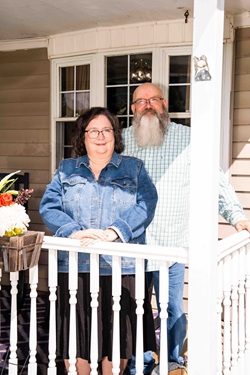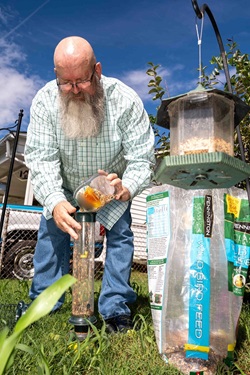A Treatment with Heart

An innovative medical device available at the University of Maryland Center for Aortic Disease offers patients with an aortic aneurysm a better solution than traditional surgery.
When Neil Olenick first sought help for back pain, vascular disease was not on his mind. The Baltimore County resident suspected a back or spine issue. After all, he had spent more than two decades in the trucking industry and many years enjoying an active lifestyle as a husband, father, grandfather and avid outdoorsman. But a routine MRI conducted to find the source of his back pain revealed something unexpected.
"The first vascular surgeon I saw told me, 'We'll get back to the back pain, no pun intended,'" Olenick said. "He had identified a small abdominal aortic aneurysm that would need regular observation."
The word "aneurysm" rang alarm bells for Olenick, whose family members had dealt with similar conditions. An aortic aneurysm is a bulge that develops at a weak point in the wall of the aorta (the heart's main artery), and it can be fatal.
Olenick was reassured to learn his aneurysm was small and required only observation, which his doctors did for nearly eight years until a CT scan revealed the aneurysm had grown large enough to require surgical intervention. And there was a complication. His aneurysm had branched out, a situation that requires advanced care and the skills of a highly trained vascular surgeon. Olenick's doctors referred him to the University of Maryland Center for Aortic Disease at the University of Maryland Medical Center, the academic medical center of the University of Maryland Medical System, where patients can receive the highest level of care for vascular conditions.
The UM Center for Aortic Disease is the only provider in the state to offer a thoracoabdominal branch endoprosthesis (TAMBE) device to treat an aortic aneurysm. This revolutionary device turns a traditionally complex, invasive operation into a two-hour, minimally invasive procedure with a recovery time of two weeks or less.
Learning About TAMBE
As soon as the Olenicks met Shahab Toursavadkohi, MD, associate professor of vascular surgery at the University of Maryland School of Medicine, they knew they were in the right place. "Dr. Tour," as he's known, also serves as co-director of the UM Center for Aortic Disease and is the principal investigator of the TAMBE device clinical trial, the research that examines how well the new medical approach works on patients.
"He immediately put me at ease," Olenick said. "He asked about our family and did his best to keep us calm. It's rare to make a connection that quickly with a doctor."
Dr. Toursavadkohi carefully explained the procedure and how it would be used to treat Olenick's aneurysm, helping him and his wife, Nancy, prepare for the next steps.
"We were given detailed information about my aneurysm and why I was a strong candidate for the procedure," Olenick said. "I saw my medical imaging for the first time, and Dr. Tour answered all of my questions."
"Neil's abdominal aneurysm had branches coming off his aorta, which made the repair more complicated," Dr. Toursavadkohi said. "Traditional treatment would involve open surgery with a long incision through the chest and abdomen. We discussed the TAMBE device in quite a bit of detail. He had a great attitude, and his background in mechanics made him especially interested in the procedure process."
A New Frontier in Aneurysm Treatment
The TAMBE device is a major advancement in the treatment of an aortic aneurysm. Dr. Toursavadkohi is leading the clinical trial testing its use with other highly skilled vascular surgeons and cardiologists.
Traditional surgery can successfully repair an aortic aneurysm, but it carries risks associated with any major surgery and requires a lengthy hospital stay and recovery.
"This procedure allows us to repair the aorta from the inside using small holes through the groin or arm and without open surgery," Dr. Toursavadkohi said. "The benefit to patients is tremendous. They no longer risk aneurysm rupture and can avoid long surgery and recovery times."
The TAMBE device is used to treat patients with an aneurysm in the abdomen or chest.
"The device comes in multiple pieces that we insert through small incisions," Dr. Toursavadkohi said. "This makes it a great option in an emergency to treat a patient with a symptomatic or ruptured aneurysm."
In addition, the device and procedure may benefit patients who might not be good candidates for open surgery, including patients with other medical conditions, older adults, those with obesity and people who don't tolerate bed rest well.
"Our patients who had surgery with the TAMBE device are doing well without any serious complications," Dr. Toursavadkohi said.
The Benefit of Expert Care
 Olenick spent four days in the hospital, only one of them in the intensive care unit.
Olenick spent four days in the hospital, only one of them in the intensive care unit.
"Any surgery requires a recovery period, even though patients having this procedure need a shorter amount of time," Dr. Toursavadkohi said. "Patients feel that they're ready to move around like normal, but we restrict those movements to allow the body time to heal."
In the year since his procedure, Olenick continues to see Dr. Toursavadkohi for regular checkups. He's doing well and feels glad the risk of a ruptured aneurysm is behind him.
"Aneurysm is a very treatable disease," Dr. Toursavadkohi said. "It's a stressful diagnosis, but patients need to know we have access to techniques and technologies to treat aneurysms with minimal pain, fast recovery and positive outcomes."
- UMMS offers comprehensive care for cardiac and vascular conditions. Find a provider online at umms.org/find-a-doctor.
